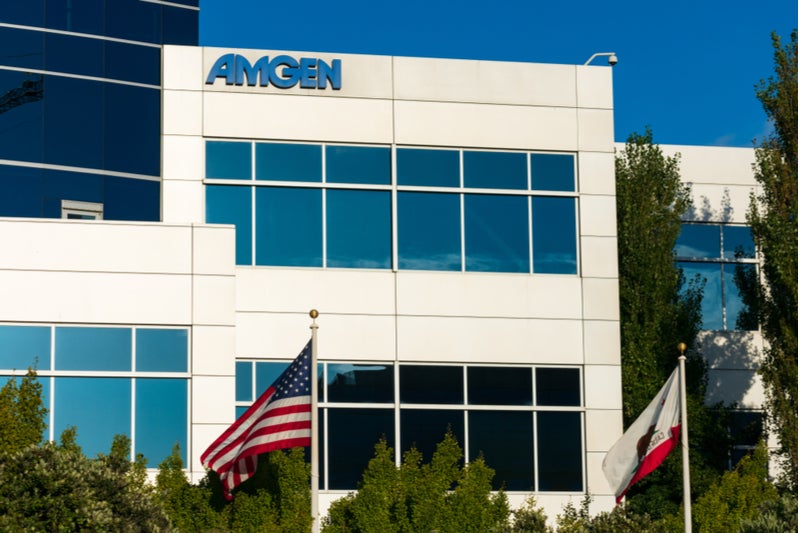Amgen is expected to activate an AMG510 combination trial in colorectal cancer (CRC) within two to three months, a Phase I investigator familiar with AMG510 clinical development plans said on the sidelines of the recently concluded European Society for Medical Oncology (ESMO) Congress.
While Amgen did not respond regarding the new combination trial plans, a spokesperson said it plans to initiate combination arms this year in CRC using PD1 and MEK inhibitors.
PD1 is a protein present on the surface of cells. A MEK inhibitor affects the MAPK/ERK pathway which is often overactive in some cancers.
The company’s stock dropped 2% after it released its Phase I/II (NCT03600883) AMG510 monotherapy data at ESMO, with analysts and media outlets underwhelmed with the CRC results.
The trial was conducted in heavily pretreated patients, and the investigator noted that if AMG510 is ultimately decided to move to an earlier line of treatment, it would need to be investigated as a combination approach to help boost its efficacy profile. The spokesperson said the potential registration-enabling Phase II trial is rapidly enrolling, and Amgen has initiated a combination arm in the Phase I trial with Merck’s anti-PD1 inhibitor Keytruda.
The new combination trial is already with regulatory authorities, added the investigator. The study is planned as an early-stage, multiarm trial, he added. Combination exploration is to investigate the 960mg AMG510 dose due to its positive safety profile and pharmacokinetic data showing this is the threshold for activity, he noted. The ongoing Phase I/II trial was designed as a dose-finding study and also includes non-small cell lung cancer (NSCLC) patients with the KRAS(G12C) mutation.
The trial’s CRC patients also had the same KRAS mutation. KRAS is a gene that acts as an on/off switch in cell signalling. When it is mutated, negative signalling is ruptured so cells can continuously proliferate, causing cancer. More progression-free survival (PFS) data, a secondary efficacy endpoint, is expected early 2020, the investigator noted. Mature PFS data would help validate AMG510’s monotherapy potential in the salvage setting, in patients who have failed at least two prior therapies, he added. AMG510 could be a $3.5bn peak revenue generator for Amgen in NSCLC and CRC, an analyst report states. Amgen has a $113.47bn market cap.
Biological difference between CRC, NSCLC impact AMG510
While AMG510 monotherapy is not delivering responses in CRC as strong as those seen in NSCLC, the therapy’s disease control rate in CRC is notable, because there are very limited treatment options in this setting, the investigator said. The question is how durable the SD data will be, as available results are not mature enough to indicate a median PFS, he added. However, it is encouraging that many patients are stable after four-to-six months, he noted.
Data presented at ESMO shows that in 12 CRC patients who received 960mg once-daily AMG510, 10 patients remained on treatment. One patient experienced a partial response (PD) and 10 had stable disease (SD), for a disease control rate of 92%. On the other hand, in 13 NSCLC patients receiving the same dose, seven patients had PD (54%) at one or more time points and six patients had SD (46%), equating to a 100% disease control rate. The ESMO abstract does not detail any PFS results.
The difference in AMG510 monotherapy data in CRC and NSCLC is due to the difference in biology between the two indications, the investigator said. CRC is a different population which has its own unique tumour biology and mutation drivers that differ from NSCLC, the spokesperson added. This news service reported 7 June that experts were not surprised in the efficacy discrepancy between CRC and NSCLC in the first two, lower doses of the Phase I/II monotherapy trial. While KRAS plays a role in the initiation and maintenance of cancer in NSCLC, it has a different role in CRC more relevant in metastatic cancer rather than primary tumour maintenance.
The theory behind combining AMG510 with a MEK inhibitor in CRC is that together they would target upstream and downstream KRAS events, the investigator explained. Anti-EGFR data in CRC shows that downstream inhibition results in EFGR phosphorylation, which is an escape mechanism for the tumour, he added. If there is feedback reactivation of the map kinase pathway, a second inhibitor would further complete this pathway to be turned off, a second Phase I/II investigator noted. However, this is still in the hypothesis stage, and there is no data available to support it, he added. The G12C version of KRAS is more common in NSCLC rather than CRC, he explained.
Another takeaway from the ESMO data is AMG510’s continuous proof of a positive safety profile, confirming that its inhibitor mechanism hits its KRAS G12C target, both investigators said. This positive safety profile makes it tempting to use it earlier for prolonged responses, the second investigator added. The majority of treatment-related adverse events (TRAE) were Grade 1 and 2, and only two TRAEs were Grade 3 (diarrhoea and anaemia), a 27 September Amgen media release states.
The 960mg dose is supported by available PK data, the spokesperson added. Based on the covalent mechanism of AMG510 and the roughly 24-hour half-life of the KRAS protein, Amgen predicted that relatively brief exposure of AMG510 would result in near-complete inhibition of KRAS and significant efficacy, he noted. AMG510 is designed to attain a maximum concentration greater than the cellular IC90 of KRAS inhibition for two-to-four hours, and based on the pharmacokinetic curves, AMG510 is above that threshold for the majority of the dosing interval, he said.
by Reynald Castaneda in London
Reynald Castaneda is a Senior Reporter for Clinical Trials Arena parent company GlobalData’s investigative journalism team. A version of this article originally appeared on the Insights module of GlobalData’s Pharmaceutical Intelligence Center. To access more articles like this, visit GlobalData.





